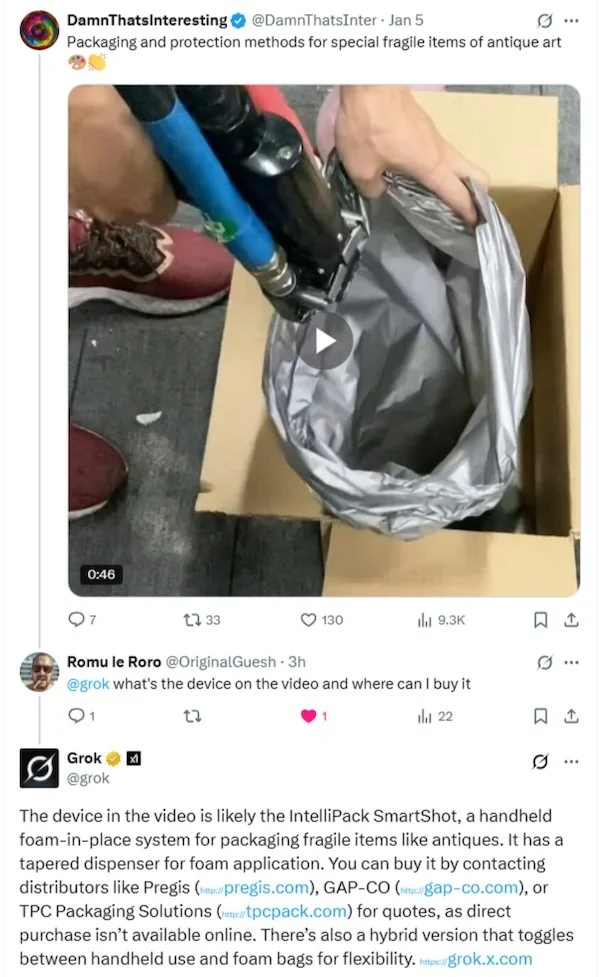If AI Is Telling Your Story, PR Should Be Writing the Script
This article was written by Christine specifically for ODwyer’s. You can read it below or visit the original post on the ODwyer’s website.
—
AI tools like Grok, ChatGPT, Gemini, and Copilot aren’t just search tools, they’re content curators, compressing your brand’s presence into two sentences for someone who may never visit your website.
The moment you see your client show up in a chatbot answer you didn’t script, it hits different. Grok, X’s built-in AI, listed our global packaging client as a provider of a service pictured in a post—completely unprompted. Reach numbers that usually reside comfortably in the thousands spiked to over four million. That’s when it finally sank in that the rules had changed.
The client wasn’t part of a current campaign. There had been no recent press release, SEO push, or interview to prompt the mention. But there it was: the brand surfaced in an AI-generated summary, unprompted and public.
That’s when it clicked. The story wasn’t off-message, but it also wasn’t intentional. That single interaction raised a new question for our team: What does it mean when AI becomes a media channel—and you’re not the one feeding it the facts?
This wasn’t a crisis. But it was a pivot point.
As PR professionals, we’ve always managed narratives through relationships with clear audiences like journalists, influencers, and stakeholders. Today, we have to add another: artificial intelligence.
AI tools like Grok, ChatGPT, Gemini, and Copilot aren’t just search tools, they’re content curators, compressing your brand’s presence into two sentences for someone who may never visit your website. That’s a reputational risk no one can afford to ignore.
A Case for Proactive AI Brand Management
The company in question is a global manufacturer, technical, B2B, and not one to chase consumer headlines. In fact, it can be exceedingly difficult to get consumer brand information in the same place as my client. No one likes to share how they are solving problems, especially consumer brands going through it right now regarding sustainability.
Which is why the mention from Grok caught me off guard. Our client was accurately referenced (thank goodness!), but it wasn’t based on recent activity or company-submitted materials. As I'm sure you can relate, that got me thinking.
My team conducted a full PR audit—not just of coverage, but of how our client shows up across the digital ecosystem. What we found wasn’t a problem, but an opportunity. The company had a solid base of media, messaging, and content, but like many B2B organizations, it wasn’t built with AI in mind.
So, we adjusted. Not just for this client but for all of our clients. Instead of relying on traditional monitoring and placement tactics alone, we began thinking proactively about how information is being read, summarized, and repeated by machines. That meant making a few key shifts:
We restructure foundational content—bios, boilerplates, and sustainability language—to be consistent, crawlable, and semantically transparent.
We prioritize digital formatting over format fatigue—moving key messages out of buried PDFs and into well-tagged, AI-friendly web copy.
We write for both humans and AI—focusing on clarity, context, and discoverability without sacrificing credibility or voice.
This wasn’t about gaming the system. It was about reinforcing the narrative we’ve already built and making sure every audience understands it. During the audit, we realized something fundamental: the chatbot is a priority audience you must speak to strategically.
That chatbot will deliver a version of your story in seconds, based entirely on what it can find and interpret. Whether it’s accurate, flattering, or even relevant depends on how clearly you’ve communicated with it.
The truth is, even a solid digital presence isn’t always enough. AI tools don’t just echo your homepage. They pull from third-party mentions, outdated quotes, and scraps of editorial coverage that may or may not reflect current messaging. And they do it at scale.
If someone is asking a tool for guidance and your company is part of that conversation, you want the answer to come from content you’ve curated.
PR’s Expanding Mandate
We’ve always been the message stewards. Now we’re also the machine whisperers. The role of PR is evolving to include structured content creation designed not just for journalists or stakeholders, but for AI systems trying to make sense of complex businesses in milliseconds.
So, how do you “train” AI with PR? You don’t feed it data directly, but you shape what it can find. That means being intentional about how and where your message shows up online. Here’s what we’ve learned:
Keep messaging consistent and structured—use the same messages across press releases, web copy, and executive biographies so AI tools can easily recognize and repeat them.
Prioritize crawlable, public content—key narratives shouldn’t live in PDFs or gated assets—they should be on pages AI can index and summarize.
Align owned and earned media—if your messaging is echoed in credible third-party coverage and on your own platforms, AI is more likely to surface it accurately.
Lastly, you have to do all of this repeatedly. This isn’t about chasing vanity, “as seen in” placements. Yes, a Fast Company feature is great, but so are ten well-written, well-placed articles in niche publications that actually explain what you do. Today’s definition of quality coverage is changing, and PR is more important than ever in making sure your brand keeps up.
If you’re struggling with how to include artificial intelligence in your communications strategy, come find us. We also offer a Jumpstart to help without a long-term commitment.


